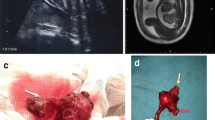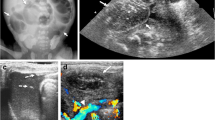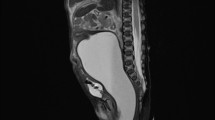Abstract
Prenatal ultrasound (US) diagnosis and postnatal outcome are reviewed in three babies with the complex form of meconium peritonitis (MP), the cystic type. Perinatal management is discussed. Large intra-abdominal cysts with signs of calcifications were detected during the second mid-trimester. Meconium ascites and polyhydramnios appeared between 32 and 35 weeks of gestation. Signs of anaemia were assessed on median cerebral artery peak systolic velocity. Sudden appearance of hydrops and anaemia required preterm delivery, neonatal resuscitation and urgent abdominal drainage. Postnatal US imaging confirmed prenatal sonographic evidence. Abdominal X-ray showed calcifications and no free abdominal air. Intestinal diversion was performed in two patients on their first day of life and evolution was uneventful. Hospital death occurred in one baby, who was submitted to delayed surgery due to unstable hemodynamic conditions. Distal ileal perforation walled off by pseudocysts was detected in all cases. One baby was found to be affected by cystic fibrosis. Ileal intussusception was described in the non-surviving infant. The cystic type of MP may have a potentially rapid lethal course and the onset of foetal anaemia and polyhydramnios is a bad prognostic factor. Severe evolution in hydrops and foetal distress may occur at any moment suggesting the persistence of a leakage or re-rupture of the cysts with new meconium spillage into the abdomen. Prenatal detection of ascites, polyhydramnios and pseudocysts requires a strict follow-up, and timing of delivery has to be planned in a tertiary centre. Postnatal radiological imaging does not offer further information over prenatal imaging and surgical decision should not be influenced by the absence of abdominal free air. Urgent abdominal drainage at birth, followed by intestinal diversion of persistent intestinal perforation on the first day of life, may prevent bacterial colonisation and improve prognosis.



Similar content being viewed by others
References
Lally KP, Mehall JR, Xue H et al (1999) Meconium stimulates a pro-inflammatory response in peritoneal macrophages :implications for meconium peritonitis. J Pediatr Surg 34:214–217. doi:10.1016/S0022-3468(99)90260-9
Kuroda T, Kitano Y, Honna T et al (2004) Prenatal diagnosis and management of abdominal disease in pediatric surgery. J Pediatr Surg 39:1819–1822. doi:10.1016/j.jpedsurg.2004.08.039
Weiner NH (2002) Prenatal ultrasound of diagnosis of meconium peritonitis secondary to cystic fibrosis. JDMS 18:43–47
Romero R, Pilu G, Jeanty P, et al. (1988) Meconium peritonitis. In : Prenatal diagnosis of congenital anomalies. Appleton and Lange, Norwalk, pp 243–245
Boix-Ochoa J, Lloret J (2003) Meconium peritonitis in newborn surgery. In: Puri P (ed) Newborn surgery, 2nd edn. Oxford University Press, Arnold, Chapter 50, pp 472–474
Molvarec A, Babinszki A, Kovacs K et al (2007) Intrauterine intestinal obstruction due to fetal midgut volvulus: a report of two cases. Fetal Diagn Ther 22:38–40. doi:10.1159/000095841
Simonovsky V, Lisy J (2007) Meconium pseudocyst secondary to ileal atresia complicated by volvolus: antenatal MR demonstration. Pediatr Radiol 37:305–309. doi:10.1007/s00247-006-0365-1
Kamata S, Nose K, Ishikawa S et al (2000) Meconium peritonitis in utero. Pediatr Surg Int 16:377–379. doi:10.1007/s003830000354
Dirkes K, Crombleholme TM, Craigo SD et al (1995) The natural history of meconium pertionitis diagnosed in utero. J Pediatr Surg 30:979–998. doi:10.1016/0022-3468(95)90325-9
Zangheri G, Andreani M, Ciriello E, Urban G, Incerti M, Vergani P (2007) Fetal intra-abdominal calcification from meconium peritonitis: sonographic predictors of postnatal surgery. Prenat Diagn 27:960–963. doi:10.1002/pd.1812
Abdel-Fattah SA, Shefras J, Kyle PM et al (2005) Reassuring fetal middle cerebral artery Doppler velocimetry in alloimmunised pregnancies: neonatal outcomes without invasive procedures. Fetal Diagn Ther 20:341–345. doi:10.1159/000086809
Shono T, Taguchi T, Suita S et al (2007) Prenatal ultrasonographic and magnetic resonance imaging findings of congenital cloacal anomalies associated with meconium peritonitis. J Pediatr Surg 42:681–684. doi:10.1016/j.jpedsurg.2006.12.060
Schwimer SR, Vanley GT, Reinke RT (1984) Prenatal diagnosis of cystic meconium peritonitis. J Clin Ultrasound 12:37–39. doi:10.1002/jcu.1870120109
Chan KL, Tang MHY, Tse HY et al (2005) Meconium peritonitis: prenatal diagnosis, postnatal management and outcome. Prenat Diagn 25:676–682. doi:10.1002/pd.1221
Eckoldt F, Helling KS, Woderich R et al (2003) Meconium peritonitis and psudo-cyst formation: prenatal diagnosis and postnatal course. Prenat Diagn 23:904–908. doi:10.1002/pd.720
Author information
Authors and Affiliations
Corresponding author
Rights and permissions
About this article
Cite this article
Pelizzo, G., Codrich, D., Zennaro, F. et al. Prenatal detection of the cystic form of meconium peritonitis: no issues for delayed postnatal surgery. Pediatr Surg Int 24, 1061–1065 (2008). https://doi.org/10.1007/s00383-008-2194-9
Accepted:
Published:
Issue Date:
DOI: https://doi.org/10.1007/s00383-008-2194-9




